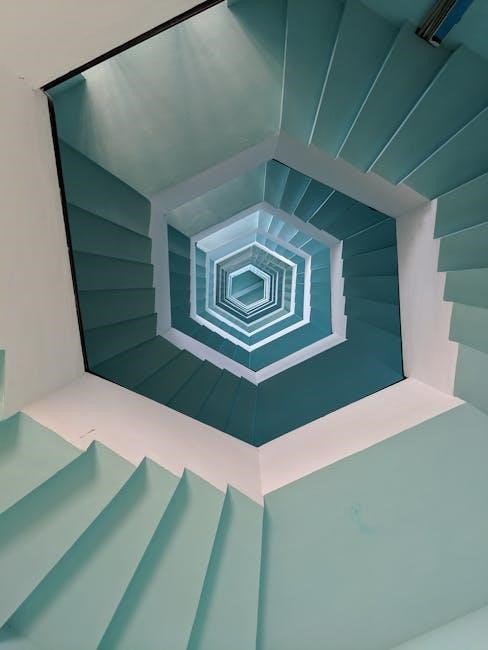Dental veneer shapes play a crucial role in achieving a natural, aesthetically pleasing smile. This guide explores how different veneer shapes can transform your dental appearance effectively.
1.1 What Are Dental Veneers?
Dental veneers are thin, custom-made shells crafted from materials like porcelain or composite resin. They are designed to cover the front surface of teeth, addressing imperfections such as discoloration, chips, or misalignment. Veneers are bonded to natural teeth to enhance aesthetics and restore confidence. Unlike implants, they are a minimally invasive solution, offering a natural appearance and durability. They are a popular choice for achieving a flawless smile, blending seamlessly with surrounding teeth for a transformative result.
1.2 Importance of Veneer Shape in Cosmetic Dentistry
Veneer shape is vital in cosmetic dentistry as it directly impacts the aesthetics and harmony of a smile. The shape influences how natural and balanced the teeth appear, aligning with facial features and personal preferences. Properly designed veneers enhance symmetry, address misalignment, and create a cohesive look. The shape must complement tooth proportions, bite alignment, and overall facial aesthetics, ensuring a seamless integration. A well-chosen shape can elevate confidence and achieve the desired smile transformation, making it a critical factor in cosmetic dental procedures.

Factors Influencing Veneer Shape
Veneer shape is influenced by face shape, tooth proportions, and personal preferences. These factors ensure a harmonious and natural-looking smile transformation, tailored to individual aesthetics and needs.
2.1 Face Shape and Its Impact on Veneer Design
Facial structure significantly influences veneer design. Oval faces suit symmetrical shapes, while square faces benefit from softer, rounded veneers to balance angles. Round faces may opt for lengthier shapes to create a slimmer appearance. The goal is to harmonize veneer shape with facial contours, ensuring a natural and cohesive smile. A cosmetic dentist assesses facial symmetry and tooth alignment to recommend the most flattering veneer design, enhancing both aesthetics and overall facial harmony.
2.2 Tooth Proportions and Aesthetics
Tooth proportions and aesthetics are vital in veneer design, ensuring a balanced and harmonious smile. The shape and size of veneers must complement the patient’s natural teeth, considering factors like tooth length, width, and alignment. Aesthetic principles, such as the golden ratio and symmetry, guide the creation of visually pleasing veneers. The materials used, such as ceramic or composite resin, also influence the final shape and appearance. A skilled cosmetic dentist assesses tooth proportions to design veneers that enhance the patient’s smile while maintaining natural-looking results.
2.3 Personal Preferences and Smile Goals
Personal preferences and smile goals significantly influence veneer shape selection. Patients may desire a more prominent smile, subtle changes, or specific aesthetic features. Smile goals vary widely, from achieving a Hollywood-style smile to correcting minor imperfections. Cosmetic dentists work closely with patients to understand their vision, ensuring veneers align with their personal style and facial features. This collaborative approach guarantees that the final result meets individual expectations, enhancing both appearance and confidence. Open communication is key to tailoring veneers that reflect each patient’s unique preferences and aspirations for their smile transformation.

Popular Veneer Shapes
Popular veneer shapes include square, rounded, and natural/anatomical designs, each offering unique aesthetic benefits tailored to individual facial features and smile goals for a personalized look.
3.1 Square Veneer Shape
The square veneer shape is a popular choice for its geometric appeal, often recommended for individuals with square face shapes. This shape features straight edges and defined angles, creating a bold, symmetrical appearance. It can enhance the smile by making the teeth appear more aligned and proportionate. Square veneers are ideal for those seeking a modern, youthful look. However, they may not suit all face types, so consulting a cosmetic dentist is essential to determine if this shape aligns with your facial aesthetics and smile goals.
3.2 Rounded Veneer Shape
The rounded veneer shape is characterized by softer edges and curved angles, offering a natural and timeless appearance. This shape is often recommended for individuals with oval or round face shapes, as it complements their facial symmetry. Rounded veneers create a gentle, harmonious smile that avoids the sharp look of square shapes. They are ideal for those seeking a subtle, elegant transformation. This shape works well for correcting misaligned or uneven teeth while maintaining a conservative aesthetic. Consulting a cosmetic dentist helps determine if rounded veneers align with your unique facial features and smile goals.
3.3 Natural or Anatomical Veneer Shape
The natural or anatomical veneer shape mimics the contours of real teeth, creating a lifelike appearance. This shape is ideal for individuals seeking a subtle, authentic smile transformation. It blends seamlessly with surrounding teeth, making it difficult to distinguish between veneers and natural enamel. The anatomical shape is often recommended for those with minor imperfections or a desire to maintain a conservative aesthetic. By replicating the natural curves and proportions of teeth, this shape ensures a cohesive and harmonious smile. It is particularly effective for correcting slight misalignments or discoloration while preserving a natural look.

How to Choose the Right Veneer Shape
Selecting the ideal veneer shape involves considering face shape, tooth proportions, and personal preferences. A balanced approach ensures a harmonious and aesthetically pleasing smile transformation.
4.1 Consulting with a Cosmetic Dentist
Consulting with a cosmetic dentist is essential for personalized advice on veneer shape. They analyze face shape, tooth proportions, and smile goals to recommend the most flattering options. Using digital tools, they create a preview of potential outcomes, ensuring alignment with your aesthetic preferences. Discussing lifestyle and oral health helps determine durability needs. A skilled dentist balances artistry and functionality, guiding you toward a customized smile solution that enhances your natural beauty while addressing cosmetic concerns.
4.2 Using Digital Smile Design Technology
Digital Smile Design (DSD) technology revolutionizes veneer shape selection by providing a visual preview of your new smile. This advanced tool uses 3D imaging to simulate how different shapes will look on your teeth, ensuring a perfect match with your facial features. Patients can see the transformation before any treatment begins, making the decision process easier. DSD also allows for precise adjustments, ensuring that the chosen shape meets both aesthetic and functional needs, offering a predictable and satisfying outcome for your veneer transformation.
4.3 Considering Lifestyle and Oral Health
Your lifestyle and oral health significantly influence veneer shape selection. Factors like teeth grinding, smoking, or frequent consumption of staining foods can affect durability and aesthetics. Patients with poor oral hygiene or gum disease may need to address these issues before veneer placement. Additionally, active lifestyles or habits that could damage teeth, such as sports, should be considered to ensure the chosen shape and material can withstand wear. Ultimately, aligning veneer shape with your lifestyle and oral health ensures a long-lasting, functional, and attractive result.

Material Types and Their Impact on Shape
Ceramic veneers are durable and aesthetically pleasing, while composite resin offers flexibility in shaping. Each material impacts the final veneer shape differently, ensuring a personalized fit.
5.1 Ceramic Veneers: Durability and Aesthetics
Ceramic veneers are renowned for their exceptional durability and natural aesthetics. Made from high-quality porcelain, they are custom-crafted to match the shape and color of your teeth, offering a lifelike appearance. Their translucent properties mimic the enamel of natural teeth, making them ideal for front teeth. Ceramic veneers are highly resistant to stains and can withstand significant chewing forces, ensuring long-term functionality. With proper care, they can last for over 20 years. Their combination of strength and beauty makes them a popular choice for achieving a flawless smile.
5.2 Composite Resin Veneers: Flexibility in Shape
Composite resin veneers are crafted from a tooth-colored plastic material, offering exceptional flexibility in shape. Unlike ceramic veneers, they can be molded and customized chairside, making them ideal for correcting minor chips or gaps. Their adaptability allows dentists to create precise, natural-looking results tailored to individual tooth structures. While less durable than ceramic, composite resin veneers are more forgiving and can be repaired easily. They are a versatile option for patients seeking a balance between aesthetics and practicality, though they may stain more easily over time.

The Process of Getting Veneers
The process of getting veneers involves an initial consultation, preparation, impressions, and bonding. Each step ensures a customized smile transformation, offering a seamless and natural-looking result that enhances both function and aesthetics.
6.1 Initial Consultation and Assessment
The initial consultation is the first step in the veneer process. During this meeting, the dentist evaluates the patient’s teeth, discusses their smile goals, and assesses the suitability of veneers. They will examine the tooth structure, alignment, and overall oral health to determine if veneers are the best option. The dentist also uses this opportunity to explain the procedure, address any concerns, and outline the expected outcomes. This thorough assessment ensures a personalized treatment plan tailored to the patient’s needs and preferences, setting the foundation for a successful transformation.
6.2 Preparation and Impressions
After the consultation, the dentist prepares the teeth by removing a thin layer of enamel to accommodate the veneers. Impressions of the prepared teeth are then taken using molds or digital scanners to create precise models. These impressions are sent to a lab where custom veneers are crafted. Temporary veneers may be placed to protect the teeth during the fabrication process. This step ensures a perfect fit and natural appearance, aligning with the patient’s smile goals and the chosen veneer shape.
6.3 Bonding and Final Adjustments
The bonding process involves applying a special dental cement to the prepared teeth, ensuring a strong and lasting hold. A curing light is used to harden the cement, securing the veneers in place. Final adjustments are made to ensure proper fit, bite alignment, and aesthetic appeal. The dentist polishes the veneers for a natural look and feel. This step is crucial for achieving both functionality and the desired cosmetic outcome, completing the transformation of your smile with precision and care.

Cost Considerations
Veneer costs vary based on materials, dentist expertise, and location. Ceramic veneers are typically more expensive than composite resin ones due to durability and aesthetic quality.
Factors like the number of teeth treated and lab fees also influence pricing. While veneers are a significant investment, they offer long-lasting, transformative results for your smile.
7.1 Factors Affecting the Cost of Veneers
The cost of veneers is influenced by several factors, including the type of material used, the dentist’s expertise, and the location of the practice. Ceramic veneers are generally more expensive than composite resin veneers due to their durability and aesthetic qualities. Additionally, the number of teeth being treated, lab fees for custom fabrication, and the complexity of the case can significantly impact the final price. Advanced technologies, such as CAD/CAM systems for precise veneer design, may also increase costs. Understanding these factors helps patients budget effectively for their dental transformation.
7.2 Regional Variations in Pricing
Veneer costs vary significantly across regions due to differences in living costs, dentist expertise, and clinic reputation. Urban areas typically charge more than rural ones. Material choice and technology also influence pricing, with advanced labs increasing fees. For instance, countries like Turkey often offer more affordable veneers compared to the U.S. or U.K., making them a popular choice for dental tourism. Patients should consult local dentists for precise quotes tailored to their needs and location, ensuring transparency in pricing and treatment planning.
Maintenance and Care
Proper care for veneers includes regular brushing, flossing, and avoiding hard foods. Regular dental check-ups ensure longevity and maintain their aesthetic appeal.
8.1 Longevity of Veneers with Proper Care
Dental veneers can last for 10 to 20 years with proper care. Regular brushing, flossing, and avoiding hard or sticky foods help maintain their durability. Ceramic veneers are more resistant to wear, while composite resin veneers may require more maintenance. Routine dental check-ups ensure early detection of any issues. Proper care not only extends the life of veneers but also preserves their aesthetic appeal, ensuring a lasting, natural-looking smile.
8.2 Tips for Maintaining Veneers
To maintain veneers, avoid chewing hard foods like ice or nuts, as they can chip the material. Use a soft-bristled toothbrush and non-abrasive toothpaste to clean gently. Regular dental check-ups are essential to monitor veneer condition and address any issues early. Avoid habits like biting nails or opening packages with teeth. If you grind your teeth at night, consider a mouthguard to protect your veneers. Proper care ensures veneers remain intact, preserving their appearance and functionality for years to come.

Real-Life Examples and Case Studies
Explore real transformations showcasing how different veneer shapes enhance smiles. Discover before-and-after photos and patient testimonials highlighting successful veneer applications and their aesthetic impact.
9.1 Before-and-After Photos of Veneer Transformations
Before-and-after photos reveal dramatic smile makeovers achieved with veneers. These visual testimonials demonstrate how different veneer shapes and materials enhance tooth alignment, color, and overall aesthetics, creating natural-looking results that boost confidence. Patients often share their journeys, showcasing transformations from chipped or discolored teeth to radiant, uniform smiles. These images not only highlight the technical skill of cosmetic dentists but also inspire others considering veneer treatments to achieve their desired smile goals. The visual evidence underscores the lasting impact of well-designed veneers on both appearance and self-esteem.
9.2 Patient Testimonials and Experiences
Patients often share inspiring stories of how veneers transformed their smiles and lives. Many highlight the seamless fitting process, natural appearance, and boosted confidence. Testimonials frequently mention the personalized approach of cosmetic dentists, ensuring veneers align with individual preferences. Others praise the durability and aesthetic appeal, noting how veneers corrected imperfections like gaps or discoloration. These experiences emphasize the emotional impact of achieving a radiant, flawless smile, encouraging others to pursue veneer treatments for similar life-changing results.

Common Myths About Veneers
A common myth is that veneers are solely for cosmetic purposes. However, they also provide structural support to damaged teeth, enhancing both appearance and functionality effectively.
10.1 Debunking Misconceptions About Veneer Shapes
A common misconception is that all veneers look unnatural or overly uniform. In reality, veneer shapes are customizable to match individual tooth proportions and facial aesthetics, ensuring a seamless blend with your natural smile. Another myth is that veneers are only for cosmetic purposes; they also provide structural support to damaged teeth; Additionally, many believe that veneers are permanent, but with proper care, they can last for decades. Consulting a cosmetic dentist helps clarify these myths and ensures the best results tailored to your needs.
10.2 Separating Fact from Fiction
While veneers are often misunderstood, it’s important to distinguish fact from fiction. One myth is that veneers make all teeth look identical, but they are actually tailored to complement individual facial features and tooth alignment. Another misconception is that veneers are only for front teeth; they can also enhance the appearance of side teeth. Additionally, the belief that veneers are fragile is untrue, as modern materials like ceramic offer durability. However, it’s true that veneers require proper care to maintain their longevity. Consulting a cosmetic dentist helps clarify these distinctions and ensures realistic expectations for your smile transformation.

The Future of Veneer Shape Technology
Digital dentistry advancements, including CAD/CAM systems and 3D printing, are revolutionizing veneer shapes. These technologies enable precise customization, ensuring a perfect fit and natural aesthetics. The future trends focus on hyper-personalized solutions, making each smile uniquely tailored.
11.1 Advancements in Digital Dentistry
Digital dentistry is revolutionizing veneer shape technology through advanced tools like CAD/CAM systems and 3D printing. These innovations enable precise measurements and custom designs, ensuring a perfect fit. Digital smile design allows patients to preview outcomes, enhancing personalization. AI-driven software predicts optimal shapes based on facial features and tooth alignment; These advancements not only improve aesthetics but also streamline production, reducing human error. The integration of virtual try-ons and real-time simulations is transforming how veneers are designed, making the process faster and more patient-centric.
11.2 Customization and Personalization Trends
Modern veneer shape trends emphasize customization, catering to individual preferences and facial aesthetics. Advanced technologies allow for tailored designs, ensuring veneers complement unique features like facial symmetry and skin tone. Patients increasingly seek personalized solutions, with options to adjust shape, size, and color. Digital tools enable precise customization, while biocompatible materials enhance comfort and durability. The rise of bespoke dentistry highlights the importance of personal style, ensuring veneers align with patients’ lifestyles and smile goals, offering natural-looking results that boost confidence and satisfaction.
Selecting the right veneer shape is key to achieving a harmonious smile. Consider face shape, tooth proportions, and personal style. Consult a cosmetic dentist for tailored results and confidence.
12.1 Final Thoughts on Choosing the Right Veneer Shape
Choosing the right veneer shape is a personal and transformative decision. Consider your face shape, tooth proportions, and smile goals. A square shape enhances symmetry, while rounded offers softness. Natural or anatomical shapes mimic real teeth for authenticity. Consulting a cosmetic dentist ensures personalized results. Digital smile design technology can preview outcomes, aiding decisions. Aligning veneer shape with lifestyle and oral health guarantees durability and satisfaction. Ultimately, the right shape boosts confidence and creates a harmonious, radiant smile tailored to your unique features and preferences.
12.2 Encouragement to Take the Next Step
Transforming your smile with veneers is a life-changing decision. Whether addressing discoloration, gaps, or chips, veneers offer a tailored solution to enhance your confidence. Take the next step by consulting a cosmetic dentist to explore your options. With modern technology and personalized care, achieving your dream smile is within reach. Don’t hesitate—empower yourself to embrace a brighter, more radiant smile that reflects your true self.